
Skoda Fabia: Storage compartments
Skoda Fabia Owners Manual
WARNING
- Do not place anything on the dash panel. These objects might slide or fall down while you are driving (under acceleration or when cornering) and could distract you from the traffic - there is a risk of an accident.
- Make sure that no objects from the centre console or from other storage compartments can get into the driver's footwell while you are driving. You would then no longer be able to apply the brakes or operate the clutch or accelerator pedal – there is a risk of an accident.
Storage compartments on the front passenger side
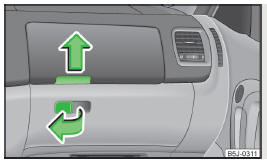
Fig. 83 Dash panel: Storage compartments on the front passenger side
Open/close
- Pull the cover handle in the direction of the arrow » Fig. 83 and fold down the cover.
- Lift the lid upwards until it clicks into place.
A pin holder is located inside the lower flap.
WARNING
The storage compartments must always be closed when driving for safety reasons.
Cooling the storage compartment on the front passenger side
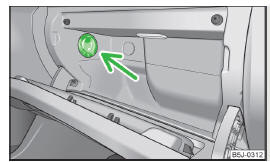
Fig. 84 Storage compartment: Using cooling system
- Use the rotary switch » Fig. 84 to open and close the air supply.
Opening the air supply when the air conditioning system is switched on allows cooled air to flow into the storage compartment.
Opening the air inlet when the air conditioning system is on causes fresh or interior air to flow into the storage compartment.
We recommend closing the air supply if it is operated in heating mode or the cooling system for the storage compartment is not being used.
Storage compartment on the driver's side
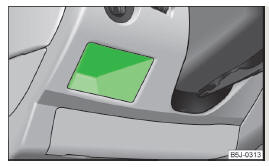
Fig. 85 Dash panel: Storage compartment on the driver's side
The open stowage compartment below the light switch » Fig. 85.
Map pockets in the front seats
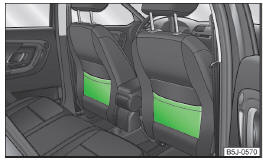
Fig. 86 Front seat rests: Map pockets
Map pockets are located on the rear of the seat backrests Fig. 86.
The map pockets are intended for storage of maps, magazines, etc.
WARNING
Never put heavy items in the map pockets – risk of injury.
CAUTION
Do not put any large items such as bottles or sharp objects into the map pockets, as the pockets and the seat covers could be damaged.
Glasses storage box
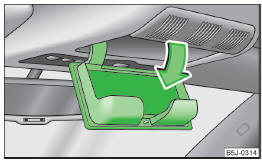
Fig. 87 Detail of the headliner: Glasses storage box
- Press on the bar in the cover of the glasses storage. The compartment folds down » Fig. 87.
WARNING
The compartment must only be opened when removing or inserting the spectacles and otherwise must be kept closed.
CAUTION
- Do not put any heat-sensitive objects in the glasses storage box - they may be damaged.
- The maximum permissible load of the glasses compartment is 250 g.
Stowage compartment in centre console

Fig. 88 Centre console: Stowage compartment
The open stowage compartment in the centre console » Fig. 88.
Stowage compartment underneath the front passenger seat
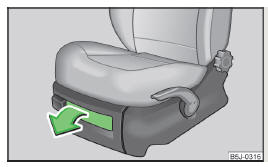
Fig. 89 Front seat: Stowage compartment
- Pull the handle to open the lid » Fig. 89.
- When closing the lid, hold the handle until the compartment is closed.
WARNING
The storage compartment must always be closed when driving for safety reasons.
CAUTION
The storage compartment is designed for storing small objects of up to 1 kg. in weight.
Front armrest with storage compartment

Fig. 90 Armrest: Storage compartment/open storage compartment
Fold the armrest forwards
- Press the lower button on the end of the armrest » Fig. 90 - A.
- Fold the arm rest forward and release the button again.
Opening the storage compartment
Press the upper button and open the cover of the stowage compartment upwards » Fig. 90 - B.
Note
The moving space of the arms can be restricted if the armrest is folded forwards.
In city traffic the armrest should not be folded forwards.
Storage compartments in the doors

Fig. 91 Storage compartment: in the front door/in the rear door
There is a bottle holder at B » Fig. 91 of the pocket in the front doors.
WARNING
Use the section A » Fig. 91 of the door pocket only for storing objects which do not project so that the effectiveness of the side airbag is not impaired.
Storage compartments in the boot
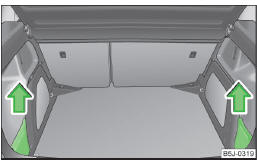
Fig. 92 Boot: Storage compartments
The cover for the side compartment can be removed, thus enlarging the boot.
- Grasp the top part of the cover and carefully remove it in the direction of the arrow » Fig. 92.
CAUTION
The storage compartments are designed for storing small objects of up to 2.5 kg. in weight in total.
Flexible storage compartment
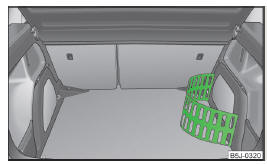
Fig. 93 Flexible storage compartment
The flexible storage compartment » Fig. 93 can be fitted to the right-hand side of the luggage compartment.
Fitting
- Insert both ends of the flexible storage compartment into the openings of the right side trim panel of the boot and push it downwards until it locks.
Removing
- Grasp the flexible storage compartment on the two upper corners.
- Press the upper corners inwards and release the storage compartment by pulling upwards
- Remove by pulling towards you.
CAUTION
The storage compartment is designed for storing small objects with a maximum total weight of 8 kg.
Note
If the variable loading floor » page 73 is installed in the luggage compartment, no flexible storage compartment can be installed.
Other info:
Mazda 2. Audio Set (Type A/Type B)
Power/Volume/Sound Controls
Clock
Operating the Radio (Type A)
Operating the Radio (Type B)
Operating the Compact Disc (CD) Player
How to use Auxiliary jack/USB port
Error Indicatio ...
Mazda 2. Towing/Tiedown Hooks
CAUTION
The towing eyelet should be used
in an emergency (to get the vehicle
out of a ditch or a snow bank, for
example).
When using the towing eyelets,
always pull the lead or chain in ...
Chevrolet Sonic. Engine Heater
The engine heater can provide easier starting and better fuel economy during
engine warm-up in cold weather conditions at or below −18°C (0°F). Vehicles with
an engine heater should be plu ...
Manuals For Car Models
-
 Chevrolet Sonic
Chevrolet Sonic -
 Citroen C3
Citroen C3 -
 Fiat Punto
Fiat Punto -
 Honda Fit
Honda Fit -
 Mazda 2
Mazda 2 -
 Nissan Micra
Nissan Micra -
 Peugeot 208
Peugeot 208 -
 Renault Clio
Renault Clio -
 Seat Ibiza
Seat Ibiza -
 Skoda Fabia
Skoda Fabia - Honda Pilot
- Volkswagen ID4
- Toyota Prius


